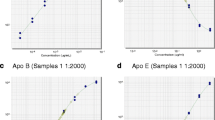Abstract
Throughout the life cycle of biopharmaceutical products, bioanalytical support is provided using ligand binding assays to measure the drug product for pharmacokinetic, pharmacodynamic, and immunogenicity studies. The specificity and selectivity of these ligand binding assays are highly dependent on the ligand binding reagents. Thus the selection, characterization, and management processes for ligand binding reagents are crucial to successful assay development and application. This report describes process considerations for selection and characterization of ligand binding reagents that are integral parts of the different phases of assay development. Changes in expression, purification, modification, and storage of the ligand binding reagents may have a profound effect on the ligand binding assay performance. Thus long-term management of the critical ligand binding assay reagents is addressed including suggested characterization criteria that allow ligand binding reagents to be used in as consistent a manner as possible. Examples of challenges related to the selection, modification, and characterization of ligand binding reagents are included.
Similar content being viewed by others
References
Porstmann T, Kiessig ST. Enzyme immunoassay techniques.J Immunol Methods. 1992;150:5–21.
Findlay JWA, Smith WC, Lee Lee JW, et al. Validation of immunoassays for bioanalysis: a pharmaceutical industry perspective.J Pharm Biol. 2000;21:1249–1273.
DeSilva B, Smith W, Weiner R, et al. Recommendations for the bioanalytical method validation of ligand-binding assays to support pharmacokinetic assessments of macromolecules.Pharm Res. 2003;20:1885–1900.
Mire-Sluis AR, Barrett YC, Devanarayan V, et al. Recommendations for the design and optimization of immunoassays used in the detection of host antibodies against biotechnology products.J Immunol Methods. 2004;289:1–16.
Geng D, Shankar G, Schantz A, Rajadhyaksha M, Davis H, Wagner C. Validation of immunoassays used to assess immunogenicity to therapeutic monoclonal antibodies.J Pharm Biol. 2005;39:364–375.
Smolec J, DeSilva B, Smith W, et al. Bioanalytical method validation for macromolecules in support of pharmacokinetic studies.Pharm Res. 2005;22:1425–1431.
Shankar G, Shores E, Wagner C, Mire-Sluis A. Scientific and regulatory considerations on the immunogenicity of biologics.Trends Biotechnol. 2006;24:274–280.
Tang L, Persky AM, Hochhaus G, Meibohm B. Pharmacokinetic aspects of biotechnology products.J Pharma Sci. 2004;93:2184–2204.
Coleman PM. Structure of antibody-antigen complexes: implications of immune recognition.Adv Immunol. 1988;43:99–132.
Butler JE.Perspectives, Configurations and Principles: Immunochemistry of Solid-phase Immunoassays. Boca Raton, FL: CRC Press; 1991:3–26.
Tijssen P.Laboratory Techniques in Biochemistry and Molecular Biology. San Diego, CA: Elsevier Science Publishers 1985.
Gosling JB, ed.Immunoassays: A Practical Approach. Oxford, UK: Oxford University Press, 2000.
Burns R.Immunochemical Protocols. Totowa, NJ: Humana Press; 2005.
Kohler G, Milstein C. Continuous cultures of fused cells secreting antibody of predefined specificity.Nature. 1975;256:495–497.
Howard GC, Bethell DR.Basic Methods in Antibody Production and Characterization. Boca Raton, FL: CRC Press; 2001.
Subramanian G.Antibodies. Vol 2. Novel Technologies and Therapeutic Use. New York, NY: Kluwer Academic/Plenum Publishers, 2004.
Bradbury AR, Mark JD. Antibodies from phage antibody libraires.J Immunol. 2004;290:29–49.
Lipvsek D, Pluckthun AJ. In-vitro protein evolution by ribosome display and mRNA display.Immunol Meth. 2004;290:51–67.
Konthur Z, Hust M, Dubel S. Perspectives for systematic in vitro antibody generation.Gene. 2005;364:19–29.
Brody EN, Gold LJ. Aptamers as therapeutic and diagnostic agents.J Biotechnol. 2000;74:5–13.
Nord K, Gunneriusson E, Ringdahl J, Stahl S, Uhlen M, Nygren PA. Binding proteins selected from combinatorial libraries of an α-helical bacterial receptor domain.Nat Biotechnol. 1997;15:772–777.
Engelbienne P.Immune and Receptor Assays in Theory and Practice. Boca Raton, FL: CRC Press; 2000.
Wong SS.Chemistry of Protein Conjugation and Cross-linking. Boca Raton, FL: CRC Press; 2000.
Niemeyer CM.Bioconjugation Protocols: Strategies and Methods. Totowa, NJ: Humana Press; 2004:283.
Kingsley DM. The TGF-beta superfamily: new members, new receptors, and new genetic tests of function in different organisms.Genes Dev. 1994;8:133–146.
Wozney JM, Rosen V. Bone morphogenetic protein and bone morphogenetic protein gene family in bone formation and repair.Clin Orthop Relat Res. 1998;346:26–37.
Webb DJ, Wen J, Karns LR, Kurilla MG, Gonias SL. Localization of the binding site for transforming growth factor-B in human alpha-2-macroglobulin to a 20-kDa peptide that also contains the bait region.J Biol Chem. 1998;273:13339–13346.
Blum WF, Ranke MB. Plasma IGFBP-3 levels as clinical indicators. In: Spencer EM, ed..Modern Concepts of Insulin-Like Growth Factors. New York, NY: Elsevier Science Publishing Co; 1991:381–393.
Harrison D, Celniker A, Reifsnyder D, Sipes D, Schroeder K, Gesundheit N. Measurement of serum insulin-like growth factor binding protein 3 using a two-site ELISA. Abstract 970 presented at: The 74th Endocrine Society Meeting; June 24–27, 1992; San Antonio, TX.
Author information
Authors and Affiliations
Corresponding author
Additional information
Published: May 11, 2007
Rights and permissions
About this article
Cite this article
Rup, B., O'Hara, D. Critical ligand binding reagent preparation/selection: When specificity depends on reagents. AAPS J 9, 16 (2007). https://doi.org/10.1208/aapsj0902016
Received:
Accepted:
DOI: https://doi.org/10.1208/aapsj0902016



